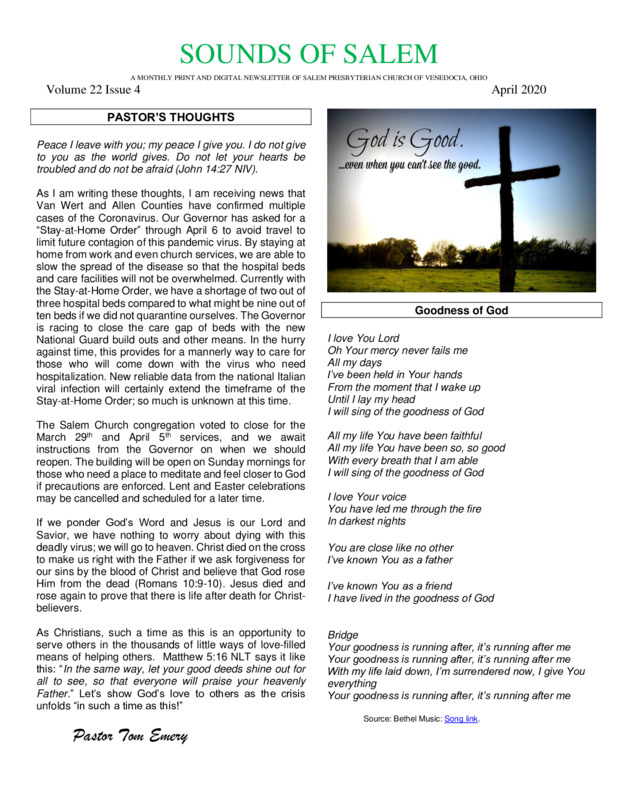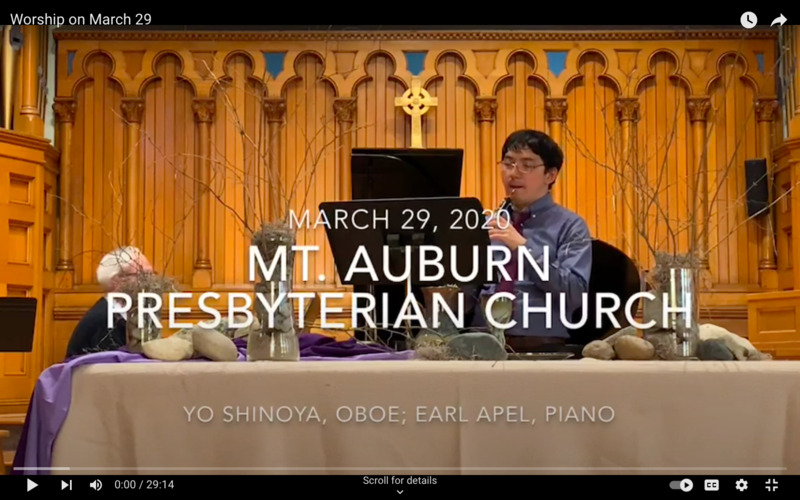Pandemic Responses in Urban and Rural Presbyterian Churches of Southern Ohio
In March of 2020, schools, businesses, and churches in Ohio began to shut down upon the rise of COVID-19 cases. Many people turned to online religious services for guidance, and clergy gained the responsibility of setting an example for how to behave, react, and practice in this new climate. Both rural and urban Presbyterian pastors in southern Ohio seemed to use their leadership status to enforce COVID-19 guidelines, however some urban pastors placed greater emphasis on metaphors to common life experiences in their preaching, focusing on life and hope, whereas some rural pastors referenced God’s presence and protection to reassure their congregations.
Urban
Three urban preachers in Cincinnati, Ohio tended to use positive messages about the pandemic and relied on metaphors to convey their messages. At the very beginning of the pandemic, in March 2020, Pastor Adam Fronczek from Knox Presbyterian Church delivered a sermon that he recorded in his own home. He began the virtual service by washing his hands while singing the hymn, “Holy, Holy, Holy”. He deliberately pointed out the fact that he was at home rather than in the church to immediately resonate with the viewers as a reminder of the changing times. The camera, directed towards his hands, outwardly displayed the message that the pandemic cannot be ignored, and safety precautions such as extra hand washing were necessary to maintain good health. Fronczek utilized religion as a way to cope with the pandemic and pushed his congregation to do the same, as demonstrated by his decision to sing a hymn to start a sermon. The unique hand-washing introduction engaged the audience while driving the message from the very beginning that “safety is a priority” and “God will help us through” (Fronczek). Fronczek used metaphors to reassure his viewers that things will return to normal soon, and a time of disorder is necessary in order to truly appreciate the calm that follows. He compared the pandemic to a Grateful Dead concert, discussing how the song order resembles orientation followed by disorientation and reorientation again. Use of this metaphor allowed Fronczek to convey his message in an relatable manner, and he established a personal connection with the audience by discussing a group and concert format which many would likely be familiar with. Although he intertwined several quotes from the Bible into his sermon, he placed a higher emphasis on making the video approachable and entertaining by using contemporary experiences as examples in his sermon. This suggests that the church may draw life lessons from popular culture, allowing Fronczek to set a positive tone with viewers and uplift people that may be struggling to cope with the pandemic.
Mt. Auburn Presbyterian Church of Cincinnati also posted a virtual service at the beginning of the pandemic, featuring a sermon delivered by Pastor Stacey Midge. Similar to Fronczek, Midge heavily relies on metaphor to convey her theme. She recalls a story from the Bible (Ezekiel ch.37) where God’s breath creates life out of a valley of bones. She uses this story as a biblical metaphor for how God will help people through the disruption of the pandemic. The use of this metaphor demonstrates that the congregation values the Bible as a source of lessons that can be applied to everyday life, as opposed to a literal guide. The story she uses displays the theme of hope and positivity, also reflected through Midge delivering this sermon using a bright and cheery voice throughout. Preaching from the biblical text helps her to engage with listeners as well as further validate her optimistic message.
As the pandemic progressed, Cincinnati’s Pleasant Ridge Presbyterian Church began to consider a positive future of Christian living for the self and their church, releasing a series of sermons in October 2021 with the theme, “Visioning the Post Quarantine Church”. Preachers covered topics such as the newfound appreciation of gathering, taking advantage of life’s opportunities, and relationships with God and others. Ultimately, the church aimed to put a positive spin on the pandemic, highlighting ways that people can learn and grow from the experience. In one of these sermons, Dr. Nicholas Yoda repeated the phrase “hold on to hope.” “Hope” has a positive connotation; with repetition, he emphasized the message of looking towards the future. Instead of dwelling on the negatives of the pandemic or placing blame, he sought to inspire optimism in the audience. Despite the pandemic lasting over a year at this point, the sermon sought to maintain a positive and encouraging perspective.
Rural
In the early months of the pandemic, many rural churches connected with their communities by normalizing feelings of fear and confusion, using scripture to support increased connection with God in a time of isolation. Pastor Lawrence Bartel of Oxford Presbyterian Church used Scripture to communicate that in uncertain times, when it can be difficult to “know where to stand” (Bartel), becoming closer with God is the only solution. He advises the congregation to look to the Beatitudes (Matthew ch.5) for advice, stating,
"In this season of the coronavirus, our mercy is being put to the test. We do not have to fear whether the Lord is among us or not. Our mission as OPC is to seek God, to serve others and to share Christ's love with all. In this season of COVID-19, the Beatitudes show us our purpose of where to stand and with whom to stand. our purpose is to connect with one another in new and creative avenues." (Bartel).
Bartel claims that COVID-19 provides an opportunity to engage with the community with God’s presence among his congregation. By acknowledging and responding to the widespread uncertainty in the church, Bartel sought for his congregation to focus on deepening their relationship with God and each other throughout the pandemic.
Thomas Emery of The Salem Presbyterian Church demonstrated his support of medical professionals to readers of the April 2020 Newsletter by endorsing both physical health recommendations as well as the use of “spiritual protection”. Thomas Emery states, “By staying at home from work and even church services, we are able to slow the spread of the disease so that the hospital beds and care facilities will not be overwhelmed” (Emery). His use of the word “even” suggests that the church views attending services as more important than work. Despite the evident importance of in-person service, Emery encouraged the Salem Church community to comply with public health guidelines and stay home. He called on his authority as a leader in the church to influence others to comply with social distancing rules. While supporting public health guidelines, Emery advocated for protections from God against serious sickness and death, saying, “— nothing even of my body can be touched by the coronavirus. Though I die, not a hair of my head will perish. Even if my body is touched by COVID-19, it cannot be harmed” (Emery). The church promoted the idea of “spiritual protection” in an attempt to ease the anxiety of the congregation.
The aforementioned churches based in Southern Ohio encouraged safety and social distancing during the COVID-19 pandemic. Urban pastors Fronczek, Midge, and Yoda relied heavily on both contemporary and biblical metaphors and positive messaging to communicate with their respective congregations, with the intention of promoting an encouraging and uplifting atmosphere. On the other hand, rural pastors Bartel and Emery primarily referenced the Bible to encourage their congregations during the pandemic, with Emery specifically discussing the concept of “God’s spiritual protection”. All the rural and urban churches in this article sought to comfort their communities, yet their methods of doing so revealed their differences in values.
Sources
Bartel, Lawrence. “March 15, 2020 - Sunday Worship Service.” YouTube. Oxford Presbyterian Church, March 17, 2020. https://www.youtube.com/watch?v=jRHd9aR2NCc&list=PLg3lK9PNIlUo1aRSlghhuK0GPWZbLbsb7&index=54
Emery, Thomas. “Sounds of Salem,” April 2020.
Fronczek, Adam. “Orientation, Disorientation, Reorientation.” Knox Church, March 22, 2020. https://www.knox.org/sermons/orientation-disorientation-reorientation.
Kurtz, Greg. “Presbyterian Service 5/24/2020.” Youtube. Covington Presbyterian Church, May 24, 2020. https://www.youtube.com/watch?v=8P2n-aYM-dM.
Midge, Stacey. “Worship on March 29.” YouTube. Mount Auburn Presbyterian, March 29, 2020. https://www.youtube.com/watch?v=YI5S4n8uXbo.
Yoda, K. Nicholas. “Visioning in the Post Quarantine Church: Gather Differently and Better.” Pleasant Ridge Presbyterian Church. Pleasant Ridge Presbyterian Church, September 26, 2021. https://prpc.org/sermons/visioning-in-the-post-quarantine-church-gather-differently-and-better/.


